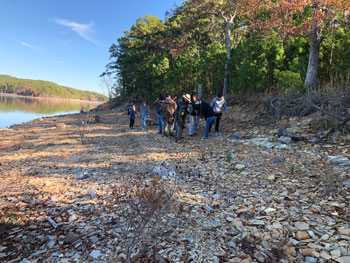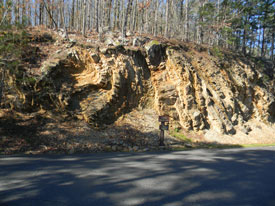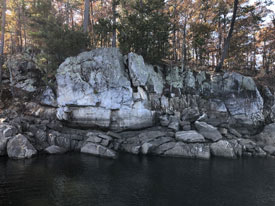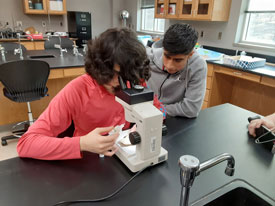

National Park College (NPC) students in Dr. George Maxey’s Physical Geology class
and Dr. Sean Hurt’s Earth Science class visited three geologic outcrops on Lake Ouachita
last month. Jen Menge of Ouachita State Park helped with the guided tour. The field trip began at Blakely Dam. “Blakely Dam exhibits excellent examples of Ordovician
age, folded and faulted rocks from the root of the Ouachita Mountains,” said Maxey.
He explained the deformities in the rocks are examples of the forces applied in creating
the Ouachita Mountains subsequent to deposition during the Ordovician period.
The field trip began at Blakely Dam. “Blakely Dam exhibits excellent examples of Ordovician
age, folded and faulted rocks from the root of the Ouachita Mountains,” said Maxey.
He explained the deformities in the rocks are examples of the forces applied in creating
the Ouachita Mountains subsequent to deposition during the Ordovician period.
Students identified rock types and were challenged to reconstruct the sequence of
events from sediments lying flat on the floor of the Tethyian sea to their present
condition.
The trip continued along Highway 7 near the entrance of Hot Springs Village, also
in the Ordovician Blakely formation. Students were tasked with locating different
types of rock and sharing what technique they used to identify the specimen. Students
used a Brunton compass to identify the rock type and measure the dip and direction
of the beds.
The field trip continued with a geofloat tour on Lake Ouachita, where students were
tasked with interpreting the geology of each outcrop. The tour included Zebra rock
where students explored the formative environment of the white quartz secondary deposition
in the Ordovician sandstone and discussed the paleohistory of the formation of the
Ouachita Mountains, including the plate tectonic collisions between South America
and North America.
They continued the tour on the north side of Lake Ouachita in Womble Shale, a recumbent
fold. Students saw the intense deformation of the rocks caused by the plate tectonic
collisions.
Checkerboard Island was the final stop on the geofloat tour. Students explored the
geology of the island. “Checkerboard Island consists of two formations, the Blakely
Sandstone and Womble Shale. A sharp contact can be seen between the two formations,”
said Maxey. While on the Island, students found fossil remains of several species
of Graptolites and two species of bivalve.
The group received permission to take the impressions back to the NPC science lab
to attempt to identify the species from the impressions. “The impressions exhibited
the form and shape of either a brachiopoda or pelecypoda,” Maxey noted. Students examined
the fossil impressions under a microscope and tested for primary carbonate residue
but the impressions were too eroded for positive identification.